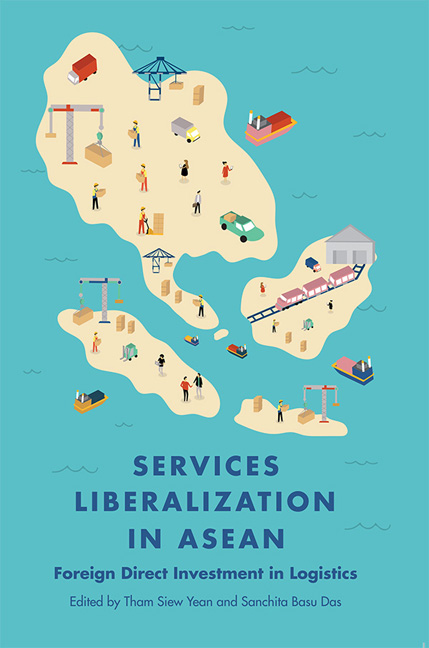Book contents
- Frontmatter
- CONTENTS
- List of Tables
- List of Figures
- Foreword
- Preface
- Acknowledgements
- Abbreviations
- About the Contributors
- 1 Introduction
- 2 Reforming Indonesia's Logistics Sector
- 3 FDI Liberalization in Malaysia's Logistics Services
- 4 Logistics Services Liberalization in the Philippines
- 5 Services Sector Liberalization in Singapore: Case of the Logistics Sector
- 6 Logistics Services Liberalization in Thailand
- 7 Services Liberalization in Vietnam: The Case of FDI in Logistics Sector
- 8 Services Liberalization: Case of Logistics in Brunei
- 9 FDI, Services Liberalization and Logistics Development in Cambodia
- 10 Services Liberalization in Lao PDR: FDI in Logistics Sector of a Land-linked Country
- 11 Facilitating FDI for the Logistics Sector in Myanmar: Agency, Incentives, and Institutions
- Index
3 - FDI Liberalization in Malaysia's Logistics Services
Published online by Cambridge University Press: 04 July 2018
- Frontmatter
- CONTENTS
- List of Tables
- List of Figures
- Foreword
- Preface
- Acknowledgements
- Abbreviations
- About the Contributors
- 1 Introduction
- 2 Reforming Indonesia's Logistics Sector
- 3 FDI Liberalization in Malaysia's Logistics Services
- 4 Logistics Services Liberalization in the Philippines
- 5 Services Sector Liberalization in Singapore: Case of the Logistics Sector
- 6 Logistics Services Liberalization in Thailand
- 7 Services Liberalization in Vietnam: The Case of FDI in Logistics Sector
- 8 Services Liberalization: Case of Logistics in Brunei
- 9 FDI, Services Liberalization and Logistics Development in Cambodia
- 10 Services Liberalization in Lao PDR: FDI in Logistics Sector of a Land-linked Country
- 11 Facilitating FDI for the Logistics Sector in Myanmar: Agency, Incentives, and Institutions
- Index
Summary
Introduction
The use of a foreign direct investment (FDI)-led development strategy in Malaysia started in the early 1970s when the first Free Trade Zone was established to attract FDI for manufacturing development. With this early mover advantage, FDI flowed into labour-intensive manufacturing based on Malaysia's host country advantages at that time such as cheap labour, economic and political stability, relatively good infrastructure and supportive government policies. Malaysia became one of the top ten developing host economies by the early 1990s but its rapid manufacturing development led to the dissipation of its low wage advantage as wages rose swiftly in response to the excess demand for labour after full employment was attained.
In recognition of the loss in competitiveness in low wage manufacturing, the government promoted a manufacturing ++ strategy based on cluster development using services development as a means to move up the value chain in the Second Industrial Master Plan (IMP2) 1996–2005. Despite this, the advent of the Asian Financial Crisis (AFC) in 1997– 98 stalled the implementation of IMP2 by redirecting the focus of government policies from industrial development towards managing the financial crisis and its aftermath. Nevertheless, the focus on service sector development continued to be prioritized in the Third Industrial Master Plan (IMP3) 2006–20, where the services sector was targeted as the next engine of growth. The development of services has shifted from its role as a facilitator for deepening manufacturing development to the development of selected services with the logistics sector as one of the targeted services. Reportedly, the government allocated RM3 billion for the development of this sector under the IMP3 with a target of 36 million TEU or 751 million tonnes of cargo to be handled by Malaysian ports by 2020 (MPC n.d.).
The emphasis on services development continued in the New Economic Model (NEM) that was launched in 2010 for re-energizing economic development. Likewise, it is also the focus of development in the Economic Transformation Plan (2010) and the Tenth Malaysia Plan (10MP) 2011–15, although the logistics sector was not included among the 12 targeted sectors in these plans.
- Type
- Chapter
- Information
- Services Liberalization in ASEANForeign Direct Investment in Logistics, pp. 77 - 109Publisher: ISEAS–Yusof Ishak InstitutePrint publication year: 2017

